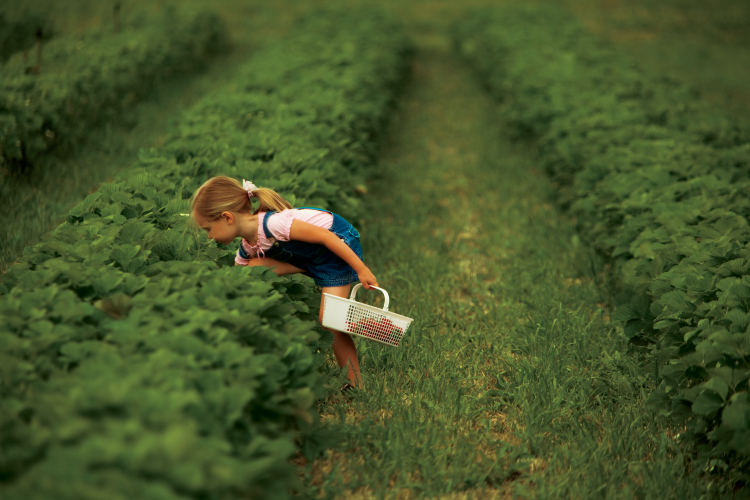Home > Lifestyle > Food For Thought > You-Pick Strawberry Fields Forever
You-Pick Strawberry Fields Forever
Warm sunshine, good exercise and lots of sweet strawberries plucked right off the vine add up to a wonderful way for families to spend the day together.

“Anyone who can walk or crawl can pick,” says Nancy Potts Edwards, whose Valley Home Farm sells both pre-picked and “pick-your-own” berries 50 miles south of Nashville.
Valley Home is one of many pick-your-own berry farms that have sprung up in recent years. The industry is a growing one, and the introduction of the plasticulture method of berry production has changed the industry significantly.
“Plasticulture requires a higher financial risk, but that’s offset by higher yields and higher quality,” Trout says. “And it extends the season.” While consumers once looked for local strawberries to arrive in mid-May, the plasticulture method produces berries as early as the third week of April.
See more: Reasons to Eat Fresh Strawberries This Spring
Valley Home is part of that dramatic change and an example of a family farm successfully adapting to the changing times and market. Purchased by the Potts in 1958, five generations – 17 family members – still live on and work the farm’s 350 acres, which include a traditional farming operation in beef cattle, broiler chickens and hay production – in addition to strawberries.
Starting a pick-your-own farm
When Larry Edwards died in 1998, Nancy searched for a way to make it economically feasible for her to stay on the farm. She says she “looked under every rock for a way to make a living” and became intrigued by the idea of a pick-your-own strawberry operation.
“My grandmother and my brother, Bob, both raised strawberries at one time, so that was already familiar to me,” Edwards says. In fact, she has memories of Granny Potts still picking strawberries a few days before her death at age 93. “And strawberries were one of the few crops that I thought would provide enough revenue for me to stay on the farm.”
Encouraged by her family, she took several courses at North Carolina State University, studied everything she could find on the subject and turned herself into a strawberry farmer.
See more: Strawberry recipes and articles about strawberries

Learning about plasticulture
Plasticulture was the wave of the future, and Edwards adopted it, with Sweet Charlies and Chandler varieties planted in September and harvested the next spring. The Valley Home Pick-Your-Own Strawberry Farm became a reality with the first planting in the fall of 2000. In the spring of 2001, visitors were welcomed to three acres of “hospitality-style” farming, focused on providing positive farm experiences for families – as well as good berries.
The plasticulture planting system requires annual transplanting of young strawberry “plugs’’ into double rows on 8-inch raised beds covered with black plastic mulch.
Farmers have discovered that berries grown in these raised beds produce an impressive yield the first season and are easier to harvest than berries grown in the more traditional fashion. The berries stay clean and disease-free. Despite a greater initial investment than for matted-row production, and the fact that plasticulture limits the crop to only one fruiting season each year, many farmers find the new system merits the change, Edwards says.
Plasticulture calls for a dual irrigation system: an overhead sprinkler system for frost- or freeze-protection of the tender blossoms and buds, and a trickle irrigation system to supply water and fertilizer. Low temperatures are the greatest threat to the crop; beginning in early March, as the blossoms begin to set, Edwards spends part of each night in the field to monitor temperatures.
“I have a frost alarm in the house that I preset, and my brother does, too,” she says. When the air temperature reaches 35 or 36 degrees, the alarm sounds and sends the pair out to the fields, where they monitor the temperatures of the delicate blossoms carefully.
If the temperature drops too low, Bob is called to activate the overhead sprinkler system. “Just the amount of heat released when that liquid water turns to ice is enough to keep the blossoms from freezing,” Edwards says.
The operation expanded to include a fall season for pumpkins and mums in its second year. The strawberry plants are mowed down and destroyed in June, and pumpkins are “second-cropped” in the same beds in July for the fall season. Each year the planting is rotated and part of the fields allowed to rest to provide for natural insect and disease control.



